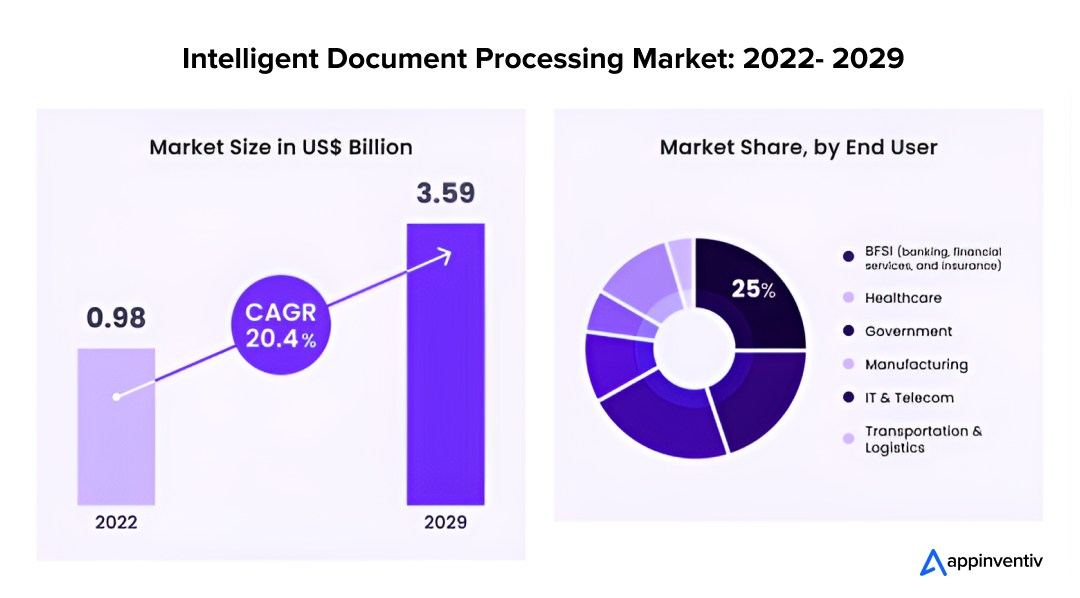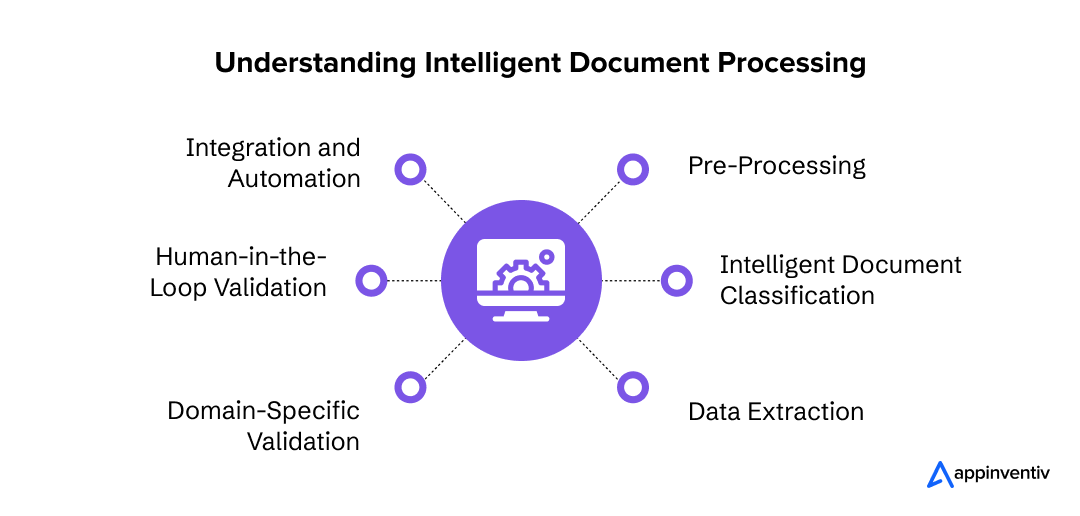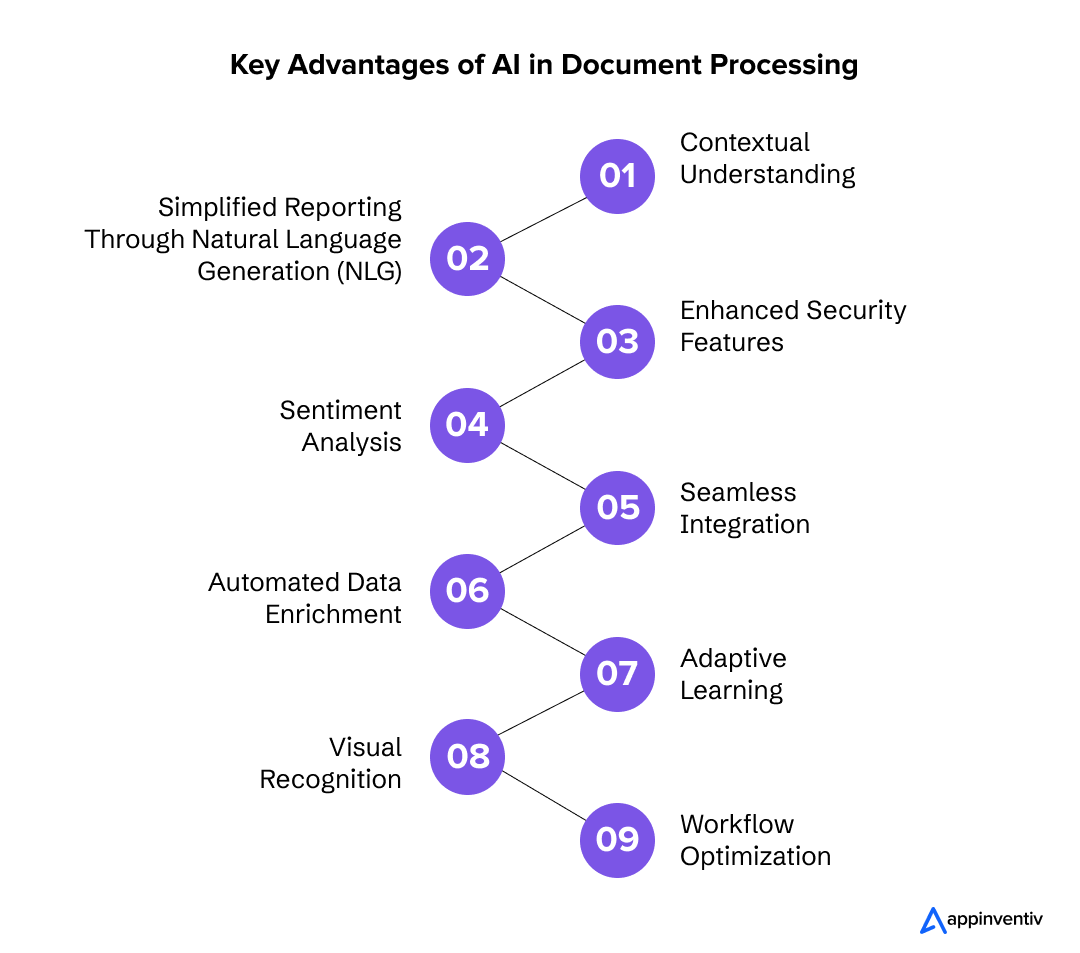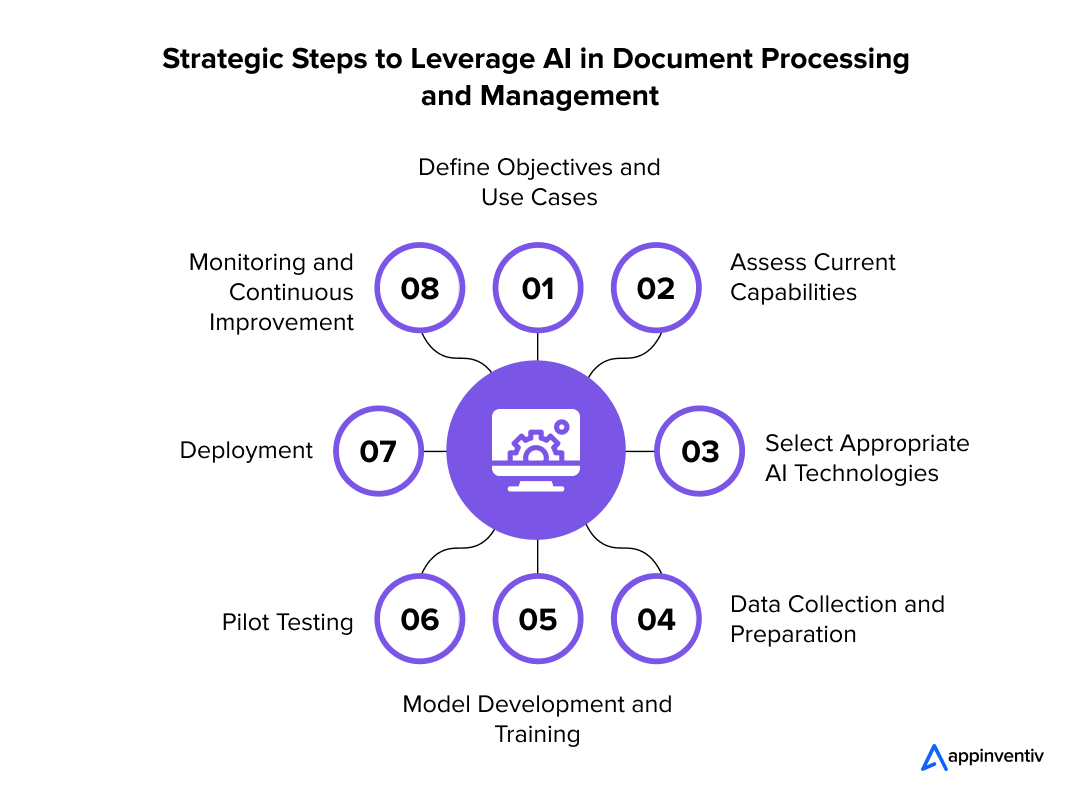- How Intelligent Document Processing Works?
- Pre-Processing
- Intelligent Document Classification
- Data Extraction
- Domain-Specific Validation
- Human-in-the-Loop Validation
- Integration and Automation
- Benefits of AI in Document Processing
- Contextual Understanding
- Simplified Reporting Through Natural Language Generation (NLG)
- Enhanced Security Features
- Easy Sentiment Analysis of Documents
- Seamless Integration
- Automated Data Enrichment
- Adaptive Learning
- Visual Recognition
- Workflow Optimization
- Innovative Technologies Driving Intelligent Document Processing Forward
- Generative AI
- Optical Character Recognition (OCR)
- Data Integration Tools
- Natural Language Processing (NLP)
- Deep Learning
- Robotic Process Automation (RPA)
- Computer Vision
- Machine Learning (ML)
- Regular Expressions (RegEx)
- Intelligent Character Recognition (ICR)
- Cloud Computing
- Semantic Analysis
- Document Clustering
- Text Mining
- Steps to Implement AI in Intelligent Document Processing and Management
- Define Objectives and Use Cases
- Assess Current Capabilities
- Select Appropriate AI Technologies
- Data Collection and Preparation
- Model Development and Training
- Pilot Testing
- Deployment
- Monitoring and Continuous Improvement
- Exploring AI Document Processing: Key Use Cases and Real-Life Applications
- Banking and FinTech
- Healthcare
- Transportation & Logistics
- Government
- Revolutionize Your Document Processing Workflows With Appinventiv
- FAQs
Nothing can be harder and more boring than mundane document processing. But what if we’ve the magic wand that can automatically extract, analyze, classify, and interpret data?
No sweat, here enters Artificial Intelligence (AI) that completely transformed the scenario of extracting, analyzing, and processing documents.
AI Leads Intelligent Document Processing!
AI is backed by advanced machine learning algorithms that enable systems to learn from data and recognize patterns, allowing faster data retrieval and fewer mistakes. As an AI interpreting mechanism, Natural language processing (NLP) can understand and interpret human language, making it a breeze to handle even the most complex documents.
According to a report by McKinsey, a prominent North American financial services firm has saved over 20,000 employee hours in just one year through its document intelligence and automation initiatives. As reported by Statista, approximately 62% of advisors utilize a combination of multiple document processing software to enhance their workflows.

This significant achievement highlights the growing momentum of the AI-based document processing market, projected to reach $3.59 billion by 2029.
By harnessing AI in document processing, organizations can speed up their workflows, boost compliance, and ultimately enhance productivity. It’s not just about saving time and resources; it’s about gaining insights to drive smarter decision-making.
So, why not let AI lighten the load and ensure you with intelligent document processing?
Let’s look deeper at the ins and outs of AI document processing.
How Intelligent Document Processing Works?
Intelligent document processing works particularly in sequences that streamline workflows, reduce manual errors, and enhance decision-making. Here’s what the role of AI in document processing looks like.

Pre-Processing
The initial phase of intelligent document processing focuses on enhancing the clarity and quality of document images. Techniques like binarization, noise reduction, de-skewing, and de-speckling are employed to prepare documents for further analysis.
Improving image quality helps ensure that Optical Character Recognition (OCR) and AI algorithms can effectively read the text, significantly reducing the likelihood of errors in subsequent steps of data processing.
Intelligent Document Classification
In the classification stage, IDP utilizes natural language processing (NLP), OCR, and machine learning to identify the type and content of documents. This intelligent classification allows for the efficient organization and routing of documents to the correct processing workflows.
Additionally, advanced techniques like Intelligent Character Recognition (ICR) enhance OCR’s capabilities, enabling the system to recognize and interpret difficult text elements better, ensuring comprehensive document understanding.
Data Extraction
During data extraction, AI algorithms help retrieve relevant information from classified documents. This can encompass various data types, including text, numerical values, and images or signatures.

IDP ensures accurate and comprehensive information capture by leveraging technologies such as NLP, deep learning, and computer vision. This further transforms raw data into structured formats suitable for analysis and processing.
Domain-Specific Validation
Following extraction, the data undergoes validation tailored to specific industry requirements. This involves applying techniques like fuzzy logic, regular expressions (RegEx), and scripting to evaluate the accuracy and relevance of the extracted data within its context.
Additionally, robotic process automation (RPA) enhances this validation process, providing further checks to ensure that the data meets the necessary standards for its intended purpose.
Human-in-the-Loop Validation
To further improve the quality of automated data processing, IDP incorporates human-in-the-loop (HITL) validation. This approach allows human intervention to correct and refine extracted data, creating a feedback mechanism that enhances the AI’s learning process.
By involving human oversight, organizations can fine-tune the training of AI models, ensuring higher accuracy and reliability in the processed information.
Integration and Automation
AI-based document processing solutions are designed to integrate seamlessly with existing business systems, providing a non-invasive approach to enhancing operations. This integration capability allows organizations to leverage intelligent automation, making previously inaccessible data actionable for business processes.
By connecting with other platforms, IDP ensures that data flows smoothly across systems, empowering organizations to optimize their workflows and drive efficiency in their operations.
Benefits of AI in Document Processing
Integrating AI in document processing offers numerous advantages, including increased efficiency and accuracy in data extraction and management. Let’s examine those in detail.

Contextual Understanding
AI systems excel at analyzing the context surrounding documents, enabling them to recognize subtle nuances and relationships that traditional methods often overlook. This ability enhances data extraction accuracy, ensuring that relevant information is prioritized. As a result, organizations can make more informed decisions based on a comprehensive understanding of their documents, ultimately improving outcomes and strategies.
Simplified Reporting Through Natural Language Generation (NLG)
With NLG capabilities, AI in document processing can automatically generate summaries, reports, and insights from processed documents, saving users significant time and effort. This feature streamlines team communication, ensuring everyone stays informed without manually reviewing extensive documents. Organizations can enhance collaboration and responsiveness by providing quick, clear insights, leading to more effective decision-making.
Enhanced Security Features
AI monitors document access patterns to identify unusual behaviors that may signal security breaches or unauthorized access. By automating the detection of potential threats, organizations can respond swiftly to safeguard sensitive information. This proactive security approach enhances overall document integrity and helps maintain compliance with data protection regulations.
Easy Sentiment Analysis of Documents
AI’s ability to evaluate the sentiment within documents, such as customer feedback or internal communications, provides valuable insights into organizational sentiment. This analysis helps businesses gauge public perception and employee morale, allowing for timely adjustments in strategy or communication. Organizations can foster better relationships with clients and employees by understanding sentiment trends and enhancing overall satisfaction.
Also Read: The Impact of AI Sentiment Analysis: Benefits and Use Cases
Seamless Integration
AI solutions are designed to integrate easily with existing software systems, enhancing their capabilities without requiring a complete overhaul. This seamless integration minimizes disruption while allowing organizations to leverage AI’s benefits effectively. By building on their current infrastructure, businesses can enhance document processing efficiency with AI while maintaining established workflows, ensuring a smooth transition to advanced technologies.
Automated Data Enrichment
Utilizing AI in document management can pull relevant information from external sources to enhance the content of documents, enriching them beyond the original data. This process provides deeper insights and allows for a more comprehensive information analysis. By presenting users with a fuller picture, organizations can make better-informed decisions and strategies based on a broader context.
Adaptive Learning
AI systems are designed to learn and evolve continuously from new data and user interactions. This adaptive learning capability means that as the system encounters new information, it refines its processes and enhances its accuracy over time. Organizations benefit from a solution that improves performance and reduces the need for frequent reprogramming, allowing teams to focus on strategic initiatives rather than technical adjustments.
Visual Recognition
Beyond text processing, AI in document management can analyze images, charts, and graphs embedded in documents, extracting valuable visual data. This capability enriches the information available to users and allows for a more holistic view of content. Organizations can leverage this visual data alongside textual information to inform decisions, improve presentations, and enhance reporting accuracy.
Workflow Optimization
AI can assess existing document processing workflows to pinpoint inefficiencies and recommend improvements. By analyzing processes, AI helps organizations streamline operations, reduce processing time, and eliminate bottlenecks. This optimization enhances productivity and ensures teams can focus on higher-value tasks, leading to a more agile and responsive organization.
Innovative Technologies Driving Intelligent Document Processing Forward
Various cutting-edge technologies are transforming IDP by enabling AI document automation, increasing accuracy, and enhancing data analysis. Let’s explore the top technologies that are making a significant impact.

Generative AI
Generative AI can help create context-aware responses or summaries based on processed documents. By leveraging these insights, organizations can enhance decision-making processes and facilitate personalized stakeholder interactions.
Optical Character Recognition (OCR)
OCR technology transforms various document types into machine-readable text, including scanned pages, PDFs, and images. This foundational step allows organizations to extract valuable textual data from physical and digital documents, making further processing and analysis possible.
Data Integration Tools
The data integration tools facilitate the seamless integration of extracted data into business systems like CRM or ERP platforms. By ensuring that processed information flows smoothly across the organization, they enhance the usability and accessibility of critical data.
Natural Language Processing (NLP)
NLP interprets and analyzes human language within documents, enabling tasks like sentiment analysis, entity recognition, and text classification. By understanding context and meaning in unstructured text, NLP enhances the ability to derive insights and make informed decisions based on document content.
Deep Learning
A subset of machine learning, deep learning utilizes neural networks to process complex datasets. This technology excels in tasks such as image recognition and language translation, making it especially valuable for documents with intricate layouts or varied languages, thereby broadening the scope of document processing.
Robotic Process Automation (RPA)
RPA automates repetitive document processing tasks such as data entry and validation. By integrating RPA with IDP, organizations can streamline workflows, minimize human error, and free up employees for more value-added activities, enhancing overall productivity.
Computer Vision
Computer vision technologies analyze visual elements within documents, allowing for the recognition of images, diagrams, and even handwritten text. IDP systems comprehensively view the document’s content by understanding these non-textual components while improving overall data extraction accuracy.
Machine Learning (ML)
ML algorithms improve the accuracy of data extraction and classification over time by learning from labeled datasets. As these models adapt to new information and patterns, they enhance processing capabilities, making them increasingly effective in handling diverse document types.
Regular Expressions (RegEx)
RegEx is a powerful tool for pattern matching in text data, often used to validate and extract specific information from documents. By identifying elements like email addresses or dates, RegEx enhances data accuracy and captures relevant information efficiently.
Intelligent Character Recognition (ICR)
ICR enhances traditional OCR by focusing on recognizing handwritten or poorly printed text. Utilizing machine learning, ICR adapts to different handwriting styles, improving its effectiveness in extracting information from diverse document formats, including forms and applications.
Cloud Computing
Cloud technologies provide the infrastructure for scalable processing of large documents, offering flexibility in accessing and managing data. This scalability allows organizations to adjust resources according to demand, optimizing operational efficiency without significant upfront investments.
Semantic Analysis
Semantic analysis focuses on comprehending the meanings of words and phrases within their specific context. This technology enhances the precision of data extraction by offering deeper insights into the relationships among terms, thereby simplifying document classification and organization.
Document Clustering
Document clustering algorithms categorize similar documents based on their content, aiding organizations in managing substantial amounts of information. By automatically sorting documents into groups, this technology improves retrieval efficiency and fosters more effective knowledge management practices.
Text Mining
Text mining involves extracting meaningful information from unstructured text by recognizing patterns and trends. This technology empowers organizations to derive valuable insights from extensive text datasets, supporting improved decision-making and strategic planning initiatives.
Steps to Implement AI in Intelligent Document Processing and Management
Implementing AI in intelligent document processing and management involves several key steps to ensure a smooth transition. Let’s check out those.

Define Objectives and Use Cases
Begin by clearly articulating your goals for integrating document processing with AI. These goals might include enhancing data accuracy, accelerating workflow efficiencies, or bolstering compliance measures.
It’s essential to outline specific use cases where AI can deliver the most significant benefits, such as automating invoice handling or streamlining contract management. Concentrating on these priorities allows you to allocate resources effectively and ensure the implementation strategy aligns closely with your broader business objectives.
Assess Current Capabilities
Conduct a comprehensive evaluation of your existing document management systems and workflows to gain insights into their strengths and weaknesses. This assessment should identify technological gaps that could impede efficient document processing, such as reliance on manual data entry or insufficient automation.
Understanding these limitations will establish a solid foundation for recognizing which areas stand to gain the most from AI integration, guiding your technology selection in the next phases.
Select Appropriate AI Technologies
Choose the right AI tools and platforms that align well with your objectives and needs. Evaluate NLP, OCR, and ML based on their relevance to your use cases.
It is also vital to ensure that the selected solutions can be integrated smoothly with your existing systems, facilitating effective workflows and maximizing the overall efficiency of document processing.
Data Collection and Preparation
Gather a diverse and comprehensive set of documents required for training your AI models, ensuring representation across various formats and content types. Preprocess this collected data to improve quality, which may involve cleaning, normalizing, and enhancing image clarity for OCR applications.
This critical preparatory phase lays the groundwork for effective AI training and ensures that the models perform accurately in real-world situations.
Model Development and Training
Develop tailored machine learning models for document classification, data extraction, and validation tasks. Utilize the prepared data to train these models, ensuring they are rigorously tested against validation datasets to confirm their accuracy and reliability.
The iterative process of testing and refining the models is crucial for achieving optimal performance, ensuring they effectively meet your organization’s unique requirements.
Pilot Testing
Execute a pilot program to evaluate the AI models in a controlled environment before proceeding with full-scale deployment. This testing phase allows you to assess their performance and uncover any issues that may arise in practical applications.
Collecting feedback from the users involved in the pilot provides valuable insights into potential challenges and areas for enhancement, which can inform necessary adjustments prior to a broader rollout.
Deployment
After refining the models through pilot testing, roll them out for full-scale use across relevant departments. Ensure that the AI-driven tools are integrated seamlessly into your existing workflows to minimize disruptions.
This comprehensive deployment phase allows your organization to leverage AI’s capabilities fully, significantly enhancing document processing efficiency across various functions.
Monitoring and Continuous Improvement
Establish a robust system for monitoring the AI models’ performance, focusing on key metrics such as accuracy, processing speed, and user satisfaction. Regularly analyzing performance data will help identify improvement areas, ensuring the models remain effective as business requirements evolve.
Continuous monitoring and optimization are essential for maintaining high levels of efficiency and accuracy in your document processing activities.
Exploring AI Document Processing: Key Use Cases and Real-Life Applications
AI document processing has become increasingly essential across various industries, streamlining workflows and enhancing efficiency. Let’s look at some top AI document processing use cases with real-life examples.

Banking and FinTech
In the finance industry, AI optimizes invoice processing by automating data extraction, which minimizes manual input and speeds up payment cycles. It also improves the review of loan applications by swiftly analyzing documents for precise decision-making.
Real-Life Application: SimFin
SimFin outlined its method for adopting IDP solutions. The company began utilizing machine learning technologies in 2017, transforming its approach. Now, it implements next-generation IDP solutions, which were updated in August 2023. With these advancements, SimFin has decreased the time spent sifting through documents, and the accuracy of the entered data has also seen significant improvement.
Healthcare
In the healthcare sector, AI supports the management of medical records by extracting and organizing patient data, enhancing accessibility for improved patient care. AI-driven patient data extraction collects essential information from various forms, aiding healthcare providers in making well-informed decisions.
Real-Life Application: Epic Systems
In August 2023, Epic Systems, a USA-based healthcare company, announced its integration with Azure OpenAI and the Ambridge Generative AI Tool to automate EHR. The goal is to minimize the time spent on completing health records. Using NLP, Epic can automatically document medical conversations and convert them into text for seamless export to EHRs.
Transportation & Logistics
Paperwork errors can disrupt shipments and lead to significant delays in delivering essential goods. Intelligent document processing (IDP) improves accuracy and operational efficiency in transportation and logistics by automatically managing various shipping documents, such as customs declaration forms, delivery receipts, bills of lading, and driver logs, available anytime and anywhere.
Real-Life Application: Deutsche Post DHL Group
Deutsche Post DHL Group, a global logistics leader, saw significant benefits from using ABBYY’s IDP to automate its finance department. The company, which generated USD 100 billion in 2022, previously relied on a manual system to process hundreds of thousands of invoices yearly. With IDP, they could automatically handle invoices in multiple languages from 124 vendors, reducing errors and boosting productivity.
Government
Managing large volumes of citizen documents, such as applications and vital records, requires significant time and resources. AI-powered document processing can optimize these workflows, improving efficiency in tasks like extracting information from legal documents and verifying application documents.
Real-Life Application: Mass Vitals
Mass Vitals, a Massachusetts-based company, stores and processes essential documents like birth and death certificates. It aims to reduce document search time, convert paper records to digital formats, and enhance security. Utilizing AWS cloud services and AI document processing, it successfully achieved these objectives.
Revolutionize Your Document Processing Workflows With Appinventiv
The future of document processing is set for significant change, propelled by advancements in artificial intelligence, machine learning, and other AI document automation technologies. As businesses produce ever-growing volumes of data, the demand for efficient document management systems will become essential.
Intelligent document processing (IDP) will be at the forefront, allowing organizations to automate extracting, classifying, and analyzing information from various document types, including invoices, contracts, and reports.
As a leading AI development company, Appinventiv is pivotal in transforming document processing workflows for organizations seeking enhanced efficiency and accuracy. By leveraging cutting-edge technology, including AI-based document processing solutions, we streamline handling various documents, from invoices to contracts. Our tailored approach to utilizing AI in document processing ensures that each solution aligns with the client’s needs, facilitating seamless integration into existing systems.
Appinventiv has successfully applied its AI capabilities in projects like JobGet, YouComm, and Vyrb, demonstrating its commitment to innovation. Appinventiv’s commitment to excellence significantly elevates document processing workflows, ultimately contributing to improved productivity and operational success across various industries.
Connect with our experts today and get started with artificial intelligence document processing.
FAQs
Q. What is artificial intelligence document processing?
A. Artificial intelligence document processing utilizes AI technologies, including machine learning, natural language processing (NLP), and optical character recognition (OCR), to automate extracting, classifying, and managing information from documents. This process encompasses analyzing unstructured data, such as text from scanned documents, emails, forms, and PDFs, and transforming it into structured data that organizations can easily process and use.
Q. Explain the impact of AI in document processing.
A. AI significantly enhances document processing by automating repetitive tasks, increasing efficiency and allowing employees to focus on higher-value work. It reduces human error through improved accuracy and minimizes operational costs by streamlining data entry.
Additionally, AI ensures compliance with regulatory standards, mitigating legal risks, and provides valuable data insights from large volumes of documents, supporting informed decision-making. Its scalability enables organizations to handle growing document needs without proportional cost increases, transforming AI in document management into a strategic advantage.
Q. What are the future trends of AI in document processing?
A. Here are some of the top future trends of artificial intelligence in document processing:
Integration with Other Technologies: AI document processing will increasingly incorporate emerging technologies like blockchain for secure document management and automation tools, creating more streamlined workflows.
Enhanced User Interfaces: Future systems may feature more intuitive interfaces that enable users to interact with document processing tools using voice commands or natural language queries.
Increased Use of NLP: As NLP technology evolves, AI systems will improve their ability to grasp context, sentiment, and linguistic nuances, allowing for more advanced document analysis and categorization.
Collaboration Tools: AI will enhance team collaboration by integrating document processing with project management and communication tools, simplifying document sharing and teamwork.



How Much Does It Cost to Build an AI Trading App Like Moomoo?
Trading apps have undoubtedly solved the major pain point of the public - eliminating middlemen from investing their money, Which keeps them in fear that they might get cheated or lose their money. However, trading apps have facilitated users with the transparency to perform trading safely and swiftly. In the era of smartphones and AI,…

15 Explorative Use Cases of AI in Mortgage Lending
In an era where technological advancements are revolutionizing every sector, mortgage lending has been slow to embrace change. The industry has been bogged down by outdated processes, increasing operational costs, and regulatory pressures. However, with the introduction of AI in mortgage lending industry, a shift is occurring that promises to address these pain points while…

How to Develop AI Medical Transcription Software? Costs, Process, and Benefits
Developing accurate and efficient medical transcriptions manually has always been a painstaking process, fraught with many challenges. Manual transcription often leads to errors, misinterpretations, delayed patient care, and the high costs associated with hiring skilled professionals. As the volume of medical data grows, the pressure to maintain accuracy without compromising efficiency intensifies. It's time to…










